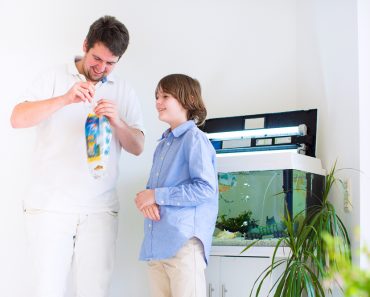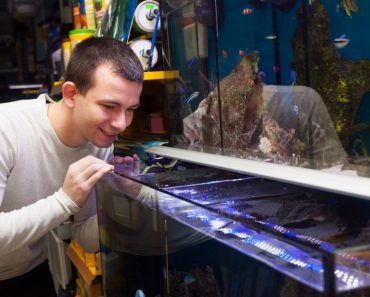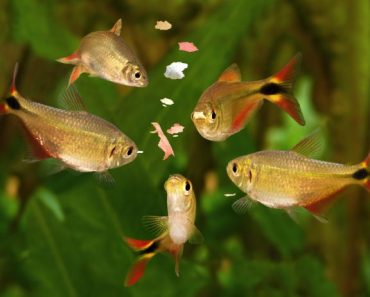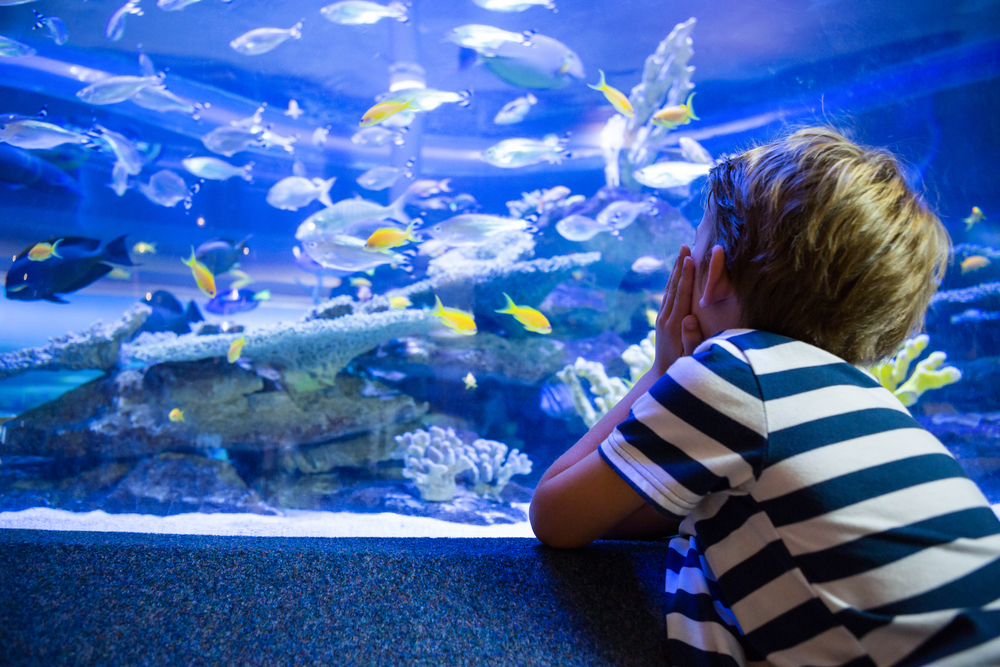 The underwater world fascinates many people and fish keeping is getting more and more popular. There are multitudes of different fish tanks available in all shapes and sizes and various beautiful landscapes consisting of plants, roots and decorations are created, drawing many admirers.
The underwater world fascinates many people and fish keeping is getting more and more popular. There are multitudes of different fish tanks available in all shapes and sizes and various beautiful landscapes consisting of plants, roots and decorations are created, drawing many admirers.
Along plants and others, a fish tank normally contains different kinds of fish species as well. Whether it is a single species tank, a habitat, the most common community aquarium, or a different variation, fresh or salt water, it is important to meet certain criteria when choosing a fish population. Not only your personal taste plays an important role, the needs of the fish themselves are very important, so they can enjoy a healthy and long life. This article will show you how to find the right fish population for your aquarium and what to look out for.
Contents
- 1 A couple of rules beforehand
- 1.1 Rules of thumb:
- 1.2 Tank dimensions
- 1.3 Reproduction of the fish
- 1.4 Avoid territorial battles
- 1.5 Males and females
- 1.6 Fishes’ special requirements for the aquarium
- 1.7 Inform yourself beforehand
- 1.8 Decide on one species of fish
- 1.9 Examples of fish population in different kinds of aquariums
- 1.10 Some examples:
- 1.11 How to insert fish properly
- 1.12 Conclusion – better collect too much information than too little
A couple of rules beforehand
It is not possible to completely freely choose what kind of fish will live in your aquarium. The fish have different requirements to water values, some species cannot live together and others need an extremely large space since they grow to a certain size after a couple of years. Every fish has their own respective way of life, which should be considered carefully when choosing it for your aquarium.
Rules of thumb:
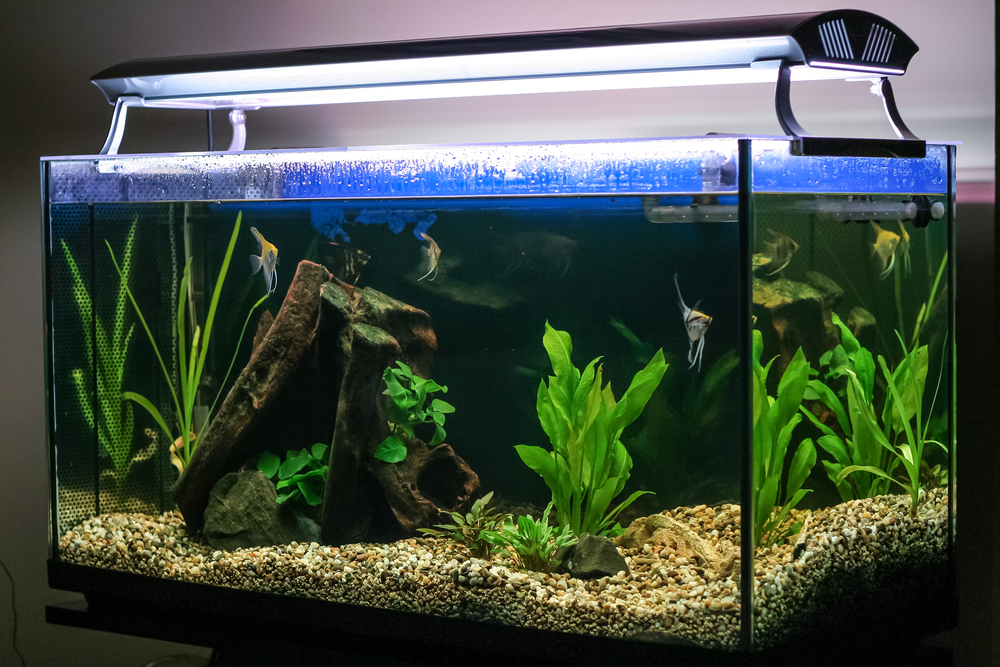
Fishes with a fully grown size of up to four centimeters should have a liter of water per centimeter of body size available. This means if you have an aquarium with 80 liters of water, you can populate it with 80-centimeter fish. You should consider that the fish will grow to a certain size, so you should always calculate by fully grown size.
Fishes larger than four centimeters need more space. Species ranging from 4 – 8 centimeters need at least two liters of water per centimeter of body length.
Fishes that grow even larger and have a fully grown size of 15 centimeters need at least three liters of water per centimeter of body length.
- up to 4 cm size: 1 liters of water per 1 cm fish
- up to 8 cm size: 2 liters of water per 1 cm fish
- up to 15 cm size: 3 liters of water per 1 cm fish
Tank dimensions
Next to the amount of water, the edge length of the aquarium has to be considered as well when looking at larger fish. Some species however do not only grow in length but also in height, for example the majestic angel fish. This means that not only the edge length is important but that the tank should also be high enough for your species.
Reproduction of the fish
There are many newcomer fish keepers who think that the amount of their fish population only shrinks because of dying fish. However there are some species that reproduce quickly and in large numbers. Examples are the popular guppies or mollies. This means your tank may quickly cease to be big enough, since the small baby fish grow quickly and start to mate with each other. In this case it is best to prevent this from happening, since incest may occur quickly if the newborn fish start to reproduce. This can lead to incest, causing dangerous deformities.
Avoid territorial battles
Furthermore you will have to consider territorial behavior of certain species. They may fight for their territory, leading to injury of the other fish. The different species’ swimming behavior is also important when choosing the right population.
Males and females
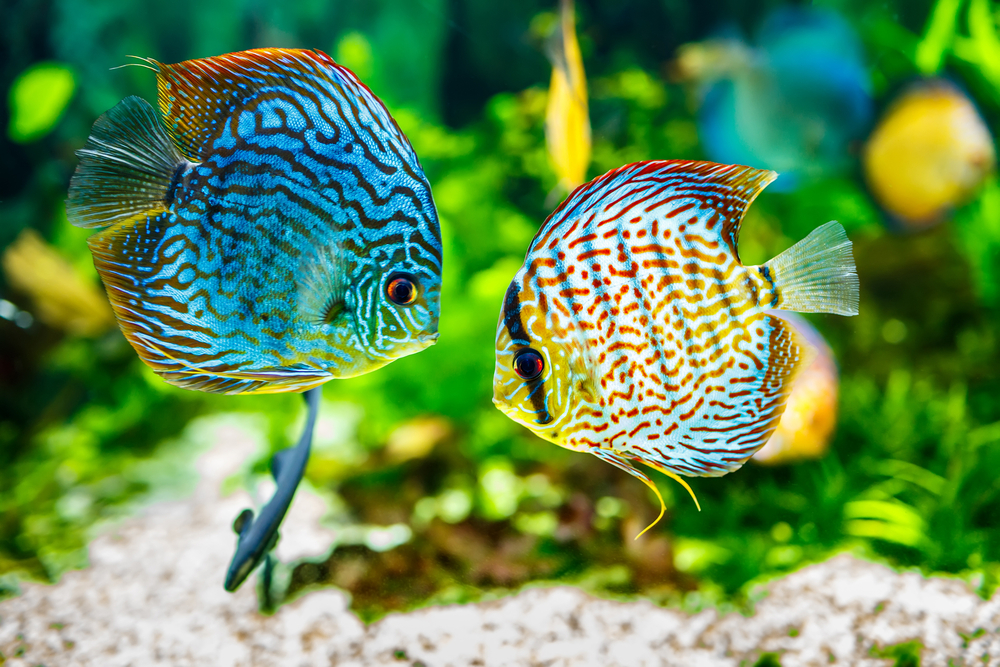 Many fish species’ males will fight for their territory among each other, so experts recommend keeping a certain number of females for every male. This is the case with guppies for example. You should keep three females for every male to avoid battles between the males and unnecessary harassment of the females since that may stress the females so much that they die from exhaustion.
Many fish species’ males will fight for their territory among each other, so experts recommend keeping a certain number of females for every male. This is the case with guppies for example. You should keep three females for every male to avoid battles between the males and unnecessary harassment of the females since that may stress the females so much that they die from exhaustion.
Fish keepers who do not want their fish to reproduce at all should either keep an all male or all female population. Since male fish tend to fight among each other it is more advisable to keep all females. A disadvantage of this method is that most species’ females are not especially colorful, mostly the males. A popular example is the guppy – females have only a single color and look almost boring compared to their male counterparts. The males have multiple colored tails and are a beautiful enrichment for any aquarium.
There are also species who should only be kept in couples, so keeping an all male or female population is not recommended with those. However these are mostly species not suitable for reproduction, like the dwarf gourami.
Other species still have males and females where their gender cannot be recognized at all at a first clance.
Fishes’ special requirements for the aquarium
Many fish species have very unique requirements for their habitat. This does not only concern water values of the fish tank. Temperature requirements are also different from species to species; some fish like it a bit cooler with a maximum temperature of 18 degrees Celsius. Others still like it more warm like the Pimelodidae. This species prefer a minimum temperature of 26 degrees Celsius. So you should keep in mind that the different species of your population have the same requirements.
This also applies to decoration. Some species need special objects to lay their eggs like the angel fish. They need objects made from clay to lay their eggs in. Catfish need caves to hide in or lay their eggs. Roots are a prerequisite for catfish as well since they aid their digestion. Without fitting roots, some species of catfish would die.
Inform yourself beforehand
In order to avoid making any mistakes it is especially important to collect information about the different species beforehand.
The following criteria are important:
- How large will the fish grow?
- How many liters of water does it at least need?
- What kind of water values does it need?
- Keep them in a swarm or as a couple?
- Do they reproduce a lot?
- Is it possible for it to live together with other fish?
- How should the fish tank be decorated?
- How much food is needed?
- What kind of temperature is required?
Decide on one species of fish
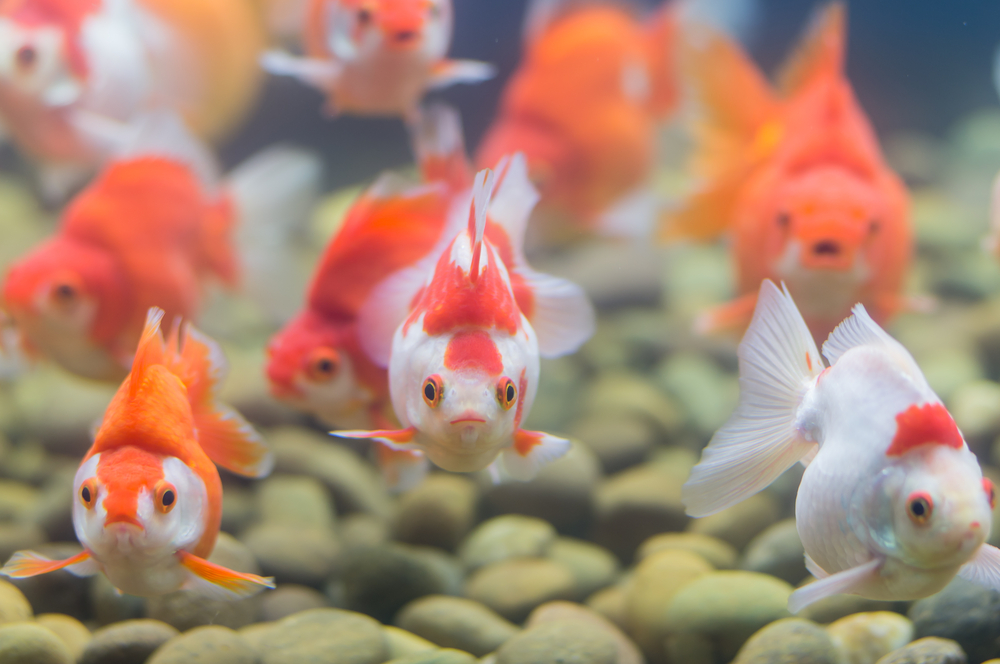 It is easiest if you decide on one species of fish at first. Choose the one that you especially like. Afterward you choose the fitting aquarium and decoration. Now you can go on looking for other species that fit with the requirements of your first one. All requirements, wheather it is decoration or water values should be fitting and they should get along with each other well as well.
It is easiest if you decide on one species of fish at first. Choose the one that you especially like. Afterward you choose the fitting aquarium and decoration. Now you can go on looking for other species that fit with the requirements of your first one. All requirements, wheather it is decoration or water values should be fitting and they should get along with each other well as well.
Examples of fish population in different kinds of aquariums
Of course there are differently sized aquariums, all of which are suitable for different fish species. Starting with the small nano tanks, beginner aquariums with a couple of hundred liters or the very large ones, reaching volumes of several thousand liters.
The decision of your final fish population is of course not only dependent on the size and decoration of your aquarium but also your own taste.
Some examples:
Nano tank
A nano tank is a very small sized aquarium. Many fish enthusiasts do not think a nano tank is a proper habitat for fish because of its very small size. That is why nano tanks are often used as water gardens, in order to create various beautiful looking landscapes. Often they are only populated with small shrimps or snails. If you want to populate it with fish anyway, you should do so with the very small species.
Betta splendens are especially popular for the nano tank. This species is not kept together with other species since it is not fit for living together with any. It especially likes to attack other fish with a colorful tail. It is important to equip the nano tank with swimming plants when keeping betta splendens.
Furthermore you can also keep boraras brigittae or galaxy rasboras in a nano tank, even though cubes starting from 60 liters volume are more fit for the latter. Boraras brigittae also feel comfortable in a small group of 7-10 animals and in a 30 liter tank. Both species are swarm animals, which should only be kept together with their kind. They are not only fit for a nano tank, you can also keep them in larger ones and groups of more than 20 individuals.
- Betta splendens (only keep alone)
- Galaxy rasbora (from 60 liters)
- Boraras brigittae (from 30 liters)
- Killifish (clown killi etc.)
- Shrimp
- Snails
Opinions are split on the nano tank. Many experts claim that a nano tank is not a proper habitat for any fish. The above mentioned betta splendens is a contrary example though. All swarm fish have the instinct to move around with their swarm, which is not possible in a cube of this size. For this reason you should not keep any in cubes of 54 liters or below and offer a big habitat even for the smaller fish species. This is especially important in the beginning and if you are unsure what size to choose – better a bit too big than too small!
54 liter aquarium
Even the 54 liter aquarium is too small for most fish species. With an aquarium like this it is important to choose the species depending on where in the tank they will live. The space at the bottom is appropriate for the cute corydoras panda, of which you can buy six or seven at least. They stay small and swim on the ground in their swarm in order to clean it. Furthermore there would be enough space left for a couple of guppies and maybe some dwarf gouramis. Add a snail here and there and you have a nice mixture of fish who have enough space to swim around.
- 7 corydoras panda for the ground
- 5 guppies
- a couple of dwarf gouramis
- snails (neritina for example)
112 liter aquarium
The next available common size is the 112 liter aquarium, which already offers enough space for different species of fish as well as space for decorating it how you please. An aquarium of this size is already ideal to populate it with 2-3 catfish. It is recommended to keep one male and two females, since males will fight for their territory and a tank of this size is too small for several territories. It is important to have some caves so the catfish can hide during the day. There should also be a root they can chew on. Now you can also add a swarm of 10-15 neon tetras as well as a ram cichlid, in order to make your aquarium something to look at.
- 2-3 catfish or a large swarm of corydoras panda
- 10-15 neon tetras (blue or black)
- ram cichlid
- snails
200 liter aquarium
The 200 liter aquarium is normally not fit for beginners. The fish enthusiast deciding for one like this should already have some experience in fish population. The ground is again suitable for multiple catfish, which can also be kept together with corydoras panda or bronze corydoras. Guppies, moonfish or percidae also feel very comfortable in this kind of tank. A possible population may be 3 armored catfish, 10 bronze corydoras and a swarm of 20 long fin blood tetra.
- 2-3 catfish
- 15 bronze corydoras
- 20 long fin blood tetras or 15 – 20 guppies and a swarm neon tetra
The above populations are only recommendations of course. Your taste should also play an important role. Please be advised not to populate the tank with too many fish but always make sure to offer them enough space to swim and feel well in.
How to insert fish properly
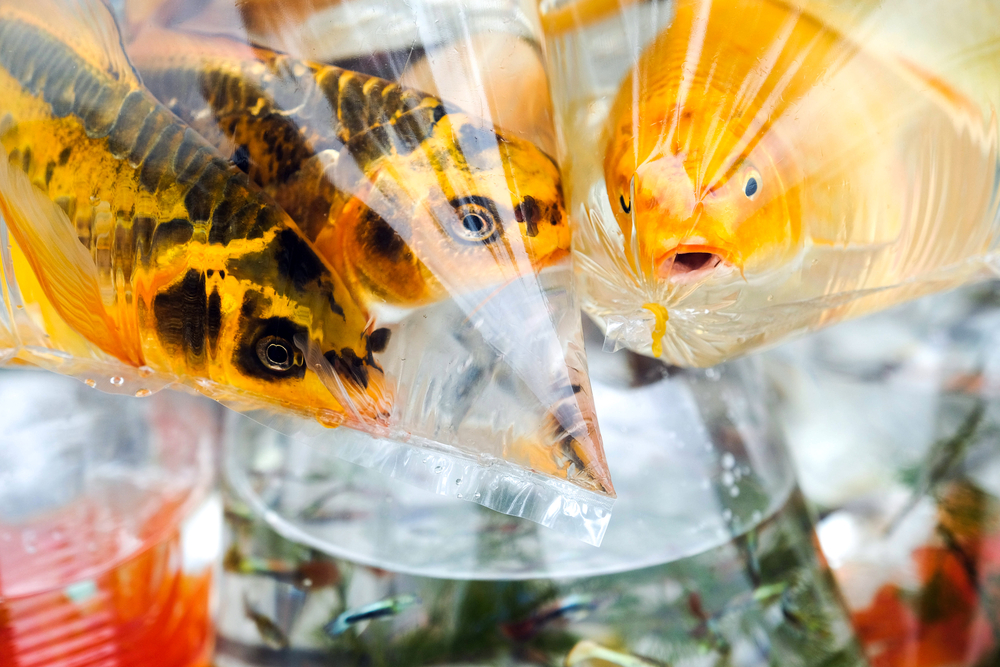 It is important to properly let the aquarium be filled in before inserting the first fish. This means letting the ground as well as the plants soak for a certain amount of time. The same goes for the technical parts as well. Water values should be tested several times during this time in order to make sure that they are stable before inserting the fish. This period should be at least four weeks long. Bacteria that are vital for the fish play an important role in this. These have to be able to settle inside the filters. By having a long period of time without any fish, the plants will be able to develop strong roots and grow to a proper size. It is important to not only let the filter do its work but also to turn on the heating and lights.
It is important to properly let the aquarium be filled in before inserting the first fish. This means letting the ground as well as the plants soak for a certain amount of time. The same goes for the technical parts as well. Water values should be tested several times during this time in order to make sure that they are stable before inserting the fish. This period should be at least four weeks long. Bacteria that are vital for the fish play an important role in this. These have to be able to settle inside the filters. By having a long period of time without any fish, the plants will be able to develop strong roots and grow to a proper size. It is important to not only let the filter do its work but also to turn on the heating and lights.
After buying the fish, they cannot be inserted directly from their bags into the aquarium. If there are no fish in the aquarium yet, please follow this advise:
- Open the bags with the fish and put them on the water surface, fasten them on the aquarium’s sides and wait 15 minutes. This way, the water can acclimate to the same temperature as the tank’s water.
- Afterward, fill half a cup water from the aquarium into the bag with the fishes, so they can start to get used to it. Repeat this 2 times and always wait 10 minutes between repetitions.
- Now get the fish from the bag with a landing net. Never put the water from the bags into your aquarium but throw it away afterward. This way you can make sure not to endanger your tank’s water values.
If there are already fish in your aquarium and you have new fish you want to add, it is advisable to put them in a different aquarium for quarantine for a certain amount of time. After a waiting period of about four weeks, you can put them in together with your existing population. This way you can stop the spreading of disease in your aquarium.
Conclusion – better collect too much information than too little
If you are unsure whether the fish you chose are fit for the population of your aquarium, it is advisable to collect information in specialist literature. Dedicated aquarium forums on the internet are also a good way for special questions. A specialist pet store or construction store where the fish are sold are often not equipped with the best knowledge. Most of the time they are mainly out to sell the fish and disregard important information.
Fotocredits: © wavebreakmedia – shutterstock.com // © Sergio Bertino – shutterstock.com // © Andrey Armyagov – shutterstock.com // © pan38 – shutterstock.com // © k_titov – shutterstock.com



